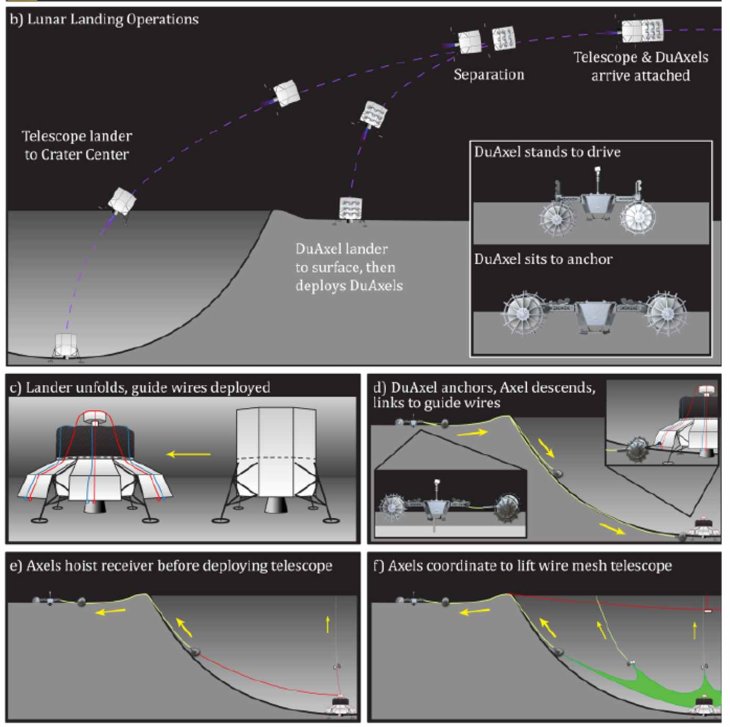NASA Funds A Telescope Built Inside A Crater On The Moon's Dark Side That Will Help Us Look Into 13.8 Billion Years Ago
Dhir Acharya - Apr 17, 2020

NASA has funded Rs 91.8 lakh for a scientist team that wants to build a telescope inside a natural crater on the dark side of the Moon.
- Russia Will Build A Lunar Space Station With China Because It's Done With NASA
- NASA Reveals 20 Most Stunning Earth Images Taken From The ISS
- Indian-Origin NASA Researcher Discovers Jupiter Moon Europa Glows In The Dark
What you see in the image below is a proposed lunar telescope that’s built inside a crater on the dark side of the Moon. If it came to life, we could use this telescope to peer back into the cosmos’ earliest days.
Earlier this month, NASA awarded more funding to several projects in its NIAC program (Innovative Advanced Concepts). The program encourages contributors to come up with creative ideas to “change the possible.”

Some proposals are really interesting, such as a solution to explore the subsurface ocean on Europa, Jupiter’s moon, instant landing pads that can be used for the upcoming lunar mission Artemis, as well as an idea of using antimatter to slow down interstellar spacecraft on the way to exoplanet Proxima Centauri b.
Among the more interesting ideas is one from Saptarshi Bandyopadhyay, a JPL roboticist. He want s to build a telescope right in a natural crater on the Moon’s other side, which he calls the Lunar Crater Radio Telescope (LCRT). The project has got a Phase 1 grant from NASA worth Rs 91.8 lakh. If Bandyopadhyay’s team comes up with a convincing proposal, they will be able to proceed to the second phase. That means there’s no telling if we will see an actual crater-telescope.
According to Bandyopadhyay, in Phase 1, the team is expected to study their concept’s feasibility.
“During Phase 1, we will mostly be focusing on the mechanical design of LCRT, searching for suitable craters on the Moon, and comparing the performance of LCRT against other ideas that have been proposed in the literature.”
He added that Phase 1 is done, they will have a better idea of when a structure could be built.

The idea for LCRT is an ultra-long-wavelength radio telescope that can capture the weakest signals that travel through space. Bandyopadhyay said:
“It is not possible to observe the universe at wavelengths greater than 10 meters [33 feet], or frequencies below 30 MHz, from Earth-based stations, because these signals are reflected by the Earth’s ionosphere. Moreover, Earth-orbiting satellites would pick up significant noise from Earth’s ionosphere.”
This is the reason why wavelengths larger than 10 meters haven’t been explored yet. Therefore, LCRT would be very helpful for cosmologists and astronomers in studying the early universe that existed 13.8 billion years ago, along with how the earliest stars formed.

When the telescope is placed on the dark side of the Moon, the observatory wouldn’t be interfered with by radio waves or other annoyances from Earth, artificial or natural.
“The Moon acts as a physical shield that isolates the lunar-surface telescope from radio interferences/noises from Earth-based sources, ionosphere, Earth-orbiting satellites, and the Sun’s radio-noise during the lunar night.”
LCRT would be built inside a crater measuring 3-5 kilometers in diameter. In the crater, various DuAxel robots would string up, then suspend and anchor a mesh that measures 1 km in diameter, making it the telescope with the largest filled-aperture in the Solar System.
>>> Ozone Layer Hole 96 Times The Size Of Taj Mahal Appears Over The Arctic, Increasing Cancer And Blindness Risks
Featured Stories

Features - Jul 01, 2025
What Are The Fastest Passenger Vehicles Ever Created?

Features - Jun 25, 2025
Japan Hydrogen Breakthrough: Scientists Crack the Clean Energy Code with...

ICT News - Jun 25, 2025
AI Intimidation Tactics: CEOs Turn Flawed Technology Into Employee Fear Machine

Review - Jun 25, 2025
Windows 11 Problems: Is Microsoft's "Best" OS Actually Getting Worse?

Features - Jun 22, 2025
Telegram Founder Pavel Durov Plans to Split $14 Billion Fortune Among 106 Children

ICT News - Jun 22, 2025
Neuralink Telepathy Chip Enables Quadriplegic Rob Greiner to Control Games with...

Features - Jun 21, 2025
This Over $100 Bottle Has Nothing But Fresh Air Inside

Features - Jun 18, 2025
Best Mobile VPN Apps for Gaming 2025: Complete Guide

Features - Jun 18, 2025
A Math Formula Tells Us How Long Everything Will Live

Features - Jun 16, 2025
Comments
Sort by Newest | Popular